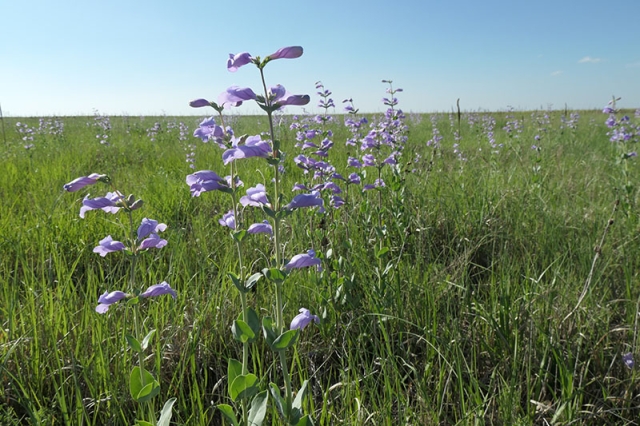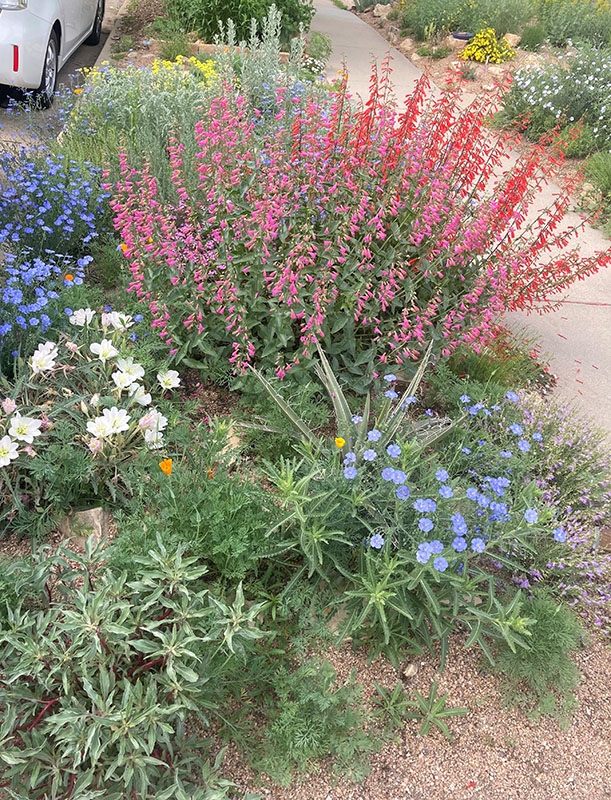Incorporating Penstemon Into Your Landscape
“You can never have too many penstemons in your yard!” my coworker recently exclaimed. I would agree. Species of this genus display showy spikes of brightly colored, bilateral flowers high above basal clumps of leaves. This is a diverse genus, however, and species range from herbaceous perennials to semi-shrubs, from 1-inch-tall cushion plants to plants with 4-foot-tall inflorescences, and leaves can be deciduous or evergreen. The floral color palette ranges from pale pink to scarlet, electric blue to grape juice purple, and snow white to almost yellow, attracting pollinators such as bumblebees and hummingbirds.

Penstemon grandiflorus in wild
The center of diversity for this genus and likely where it originated is Utah. In fact, there are more than 100 species of penstemon native to the arid and rocky beehive state. Colorado, with 65 taxa, may be the state with the second highest number of penstemon species. This means penstemon are adapted to the harsh climate of our region and, as a result, have gained popularity in landscaping. Many straight species and cultivars are available in the nursery trade and what follows are a few of my favorites.
Desert penstemon (Penstemon pseudospectabilis) is a long-lived species with spikes of pink flowers, which are a magnet for broad-tailed hummingbirds. Evergreen leaves provide winter interest.
Beardlip penstemon (P. barbatus) has brilliant reddish orange, downward-pointing flowers, characteristics that attract hummingbirds. Deadhead this penstemon after its flowers fade, and you may be rewarded with a second bloom in the fall.
Rocky Mountain penstemon (P. strictus) is another long-lived, easy-to-grow penstemon that naturalizes with time. Flowers are bluish-purple and attract bumblebees.
Palmer’s penstemon (Penstemon palmeri) has tall spikes of large, pale pink, rose-scented flowers and blue green, evergreen leaves. Flowers attract very large bumblebees!
Large-flowered beardtongue (P. grandiflorus). A more precise common name would be “the largest-flowered beardtongue ever” as flowers are almost exaggerated in size. This species often behaves as an annual or biennial but will seed around if allowed. Flowers are pink, blue lavender, or pale blue.
Pineleaf penstemon (P. pinifolius) is a diminutive species with linear evergreen leaves and red orange tubular flowers. ‘Mersea Yellow’ is a selection with yellow flowers and flowers of STEPPE SUNS® sunset glow are a warm orange.
SILVERTON® bluemat penstemon (P. linarioides ssp. coloradoensis ‘P014S’) of Plant Select® is another easy-to-grow small penstemon with silvery, evergreen leaves and lavender blue flowers.
Bridges’ penstemon (P. rostriflorus) is a late-bloomer that provides a final burst of red blooms late-July through August.

Penstemon pseudospectabilis P.eatonii
Tips for Growing Penstemon
- Select a sunny, open site with well-draining soils. If needed, amend your soil with expanded shale or squeegee to improve drainage. Penstemons thrive in disturbed sites!
- Mulch with pea gravel instead of wood chips.
- Water deeply but infrequently.
- Avoid synthetic fertilizers, or any fertilizer at all really.
Penstemons typically produce firecracker-like bursts of color from May through June and then are quiet for the rest of the season. To extend color and textural interest in your garden, select companion plants with similar water needs. My favorites include Artemisia, Agave, Hesperaloe, yarrow, blue flax, orange milkweed, chocolate flower, Colorado four o’clock and dwarf baby blue rabbitbrush.
Happy planting!
This article originally appeared in the August 2021 issue of Life on Capitol Hill.
Add new comment